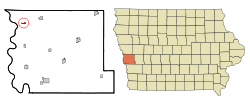Demographics
2020 census
As of the census of 2020, [7] there were 166 people, 72 households, and 39 families residing in the city. The population density was 462.3 inhabitants per square mile (178.5/km2). There were 97 housing units at an average density of 270.2 per square mile (104.3/km2). The racial makeup of the city was 93.4% White, 1.2% Black or African American, 0.6% Native American, 0.0% Asian, 0.0% Pacific Islander, 2.4% from other races and 2.4% from two or more races. Hispanic or Latino persons of any race comprised 7.2% of the population.
Of the 72 households, 20.8% of which had children under the age of 18 living with them, 37.5% were married couples living together, 9.7% were cohabitating couples, 26.4% had a female householder with no spouse or partner present and 26.4% had a male householder with no spouse or partner present. 45.8% of all households were non-families. 41.7% of all households were made up of individuals, 27.8% had someone living alone who was 65 years old or older.
The median age in the city was 51.0 years. 20.5% of the residents were under the age of 20; 3.6% were between the ages of 20 and 24; 17.5% were from 25 and 44; 27.1% were from 45 and 64; and 31.3% were 65 years of age or older. The gender makeup of the city was 53.6% male and 46.4% female.
2010 census
As of the census [8] of 2010, there were 170 people, 78 households, and 51 families living in the city. The population density was 459.5 inhabitants per square mile (177.4/km2). There were 108 housing units at an average density of 291.9 per square mile (112.7/km2). The racial makeup of the city was 100.0% White. Hispanic or Latino of any race were 2.4% of the population.
There were 78 households, of which 23.1% had children under the age of 18 living with them, 46.2% were married couples living together, 12.8% had a female householder with no husband present, 6.4% had a male householder with no wife present, and 34.6% were non-families. 33.3% of all households were made up of individuals, and 14.1% had someone living alone who was 65 years of age or older. The average household size was 2.18 and the average family size was 2.67.
The median age in the city was 48.5 years. 17.1% of residents were under the age of 18; 5.8% were between the ages of 18 and 24; 18.9% were from 25 to 44; 38.9% were from 45 to 64; and 19.4% were 65 years of age or older. The gender makeup of the city was 52.4% male and 47.6% female.
2000 census
As of the census [9] of 2000, there were 217 people, 96 households, and 62 families living in the city. The population density was 620.2 inhabitants per square mile (239.5/km2). There were 111 housing units at an average density of 317.2 per square mile (122.5/km2). The racial makeup of the city was 99.54% White, 0.46% from other races. Hispanic or Latino of any race were 0.46% of the population.
There were 96 households, out of which 22.9% had children under the age of 18 living with them, 51.0% were married couples living together, 10.4% had a female householder with no husband present, and 34.4% were non-families. 29.2% of all households were made up of individuals, and 16.7% had someone living alone who was 65 years of age or older. The average household size was 2.26 and the average family size was 2.78.
In the city, the population was spread out, with 20.7% under the age of 18, 9.2% from 18 to 24, 24.9% from 25 to 44, 26.3% from 45 to 64, and 18.9% who were 65 years of age or older. The median age was 42 years. For every 100 females, there were 92.0 males. For every 100 females age 18 and over, there were 89.0 males.
The median income for a household in the city was $28,583, and the median income for a family was $29,750. Males had a median income of $27,321 versus $16,250 for females. The per capita income for the city was $20,410. About 13.4% of families and 17.8% of the population were below the poverty line, including 28.0% of those under the age of eighteen and 21.2% of those 65 or over.
This page is based on this
Wikipedia article Text is available under the
CC BY-SA 4.0 license; additional terms may apply.
Images, videos and audio are available under their respective licenses.





